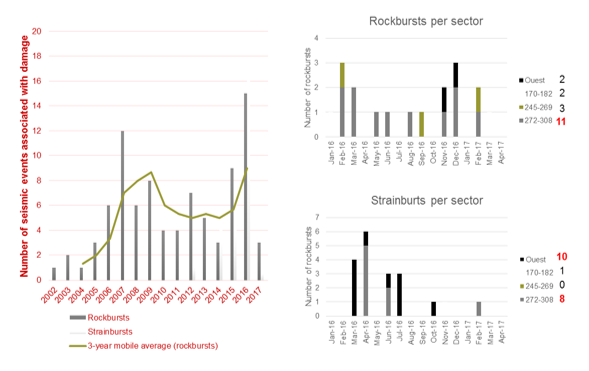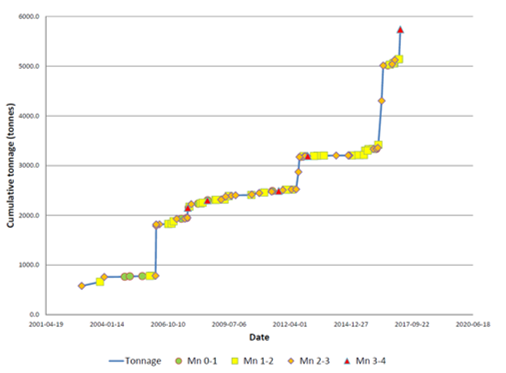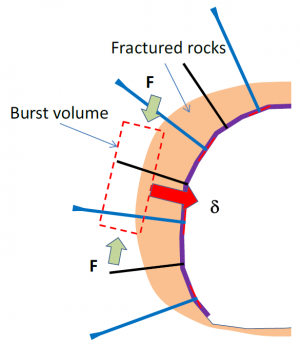9. Ground support
Ground support is often perceived as the main tool to mitigate the consequence of seismicity. Based on a forecast of the largest events in each area of the mines, ground support systems are designed and implemented to contain such events. Despite a large effort by the industry to improving knowledge of dynamic ground support behaviour, the theoretical basis and design methodologies for dynamic ground support remain deficient.
9.1 Design for dynamic load
9.1.1 Basic practices
The dynamic support implemented has been incrementally improved in most mines because of retrospective lessons learnt from rockburst damage. The support elements which failed have been replaced by stronger and/or yielding elements.
Most mines also justify their dynamic support selection with calculations based on the Canadian Rockburst Research Program methodology (Mining Research Directorate 1996).
9.1.2 Advanced practices
There are major gaps in current knowledge to enable accurate design calculations for dynamic support. Both the estimation of energy demand from seismic events and the energy capacity of support systems rely on many unverifiable assumptions. Nevertheless, dynamic support design practices are regarded as being advanced practice when a significant effort is spent on quantifying the key demand and capacity parameters for analytical calculations.
A number of empirical techniques have also been proposed by Heal (2010) in (a) of the below figure, Turcotte (2014) in (b) of the below figure, Mikula (2012) in (c) of the below figure, Villaescusa et al. (2014) in (d) of the below figure and Morissette and Hadjigeorgiou (2017) in (e) of the below figure. The calibration of any of these empirical methods to local mine conditions is a good design tool and represents advanced practice, but it requires time and back analysis of a significant database.

Figure: Examples of empirical techniques calibrated at a number of mine sites proposed a) Heal (2010), b) Turcotte (2014), c) Mikula (2012), d) Villaescusa et al. (2014) e) Morissette and Hadjigeorgiou (2017)
Counter (2017) use such a database collected over many years at Kidd to develop a ground support survivability matrix, as shown in the following figure. This is another example of an advanced practice providing a very useful dynamic ground support selection tool.

9.2 Performance evaluation
9.2.1 Basic practices
Most mines operating in developed countries are required by law to report at least the significant fall of grounds and, as such, significant rockburst damage. It is basic practice that mines produce reports that are more comprehensive than what is required by the regulators. The more severe the damage, the more comprehensive the investigation and report.
9.2.2 Advanced practices
Advanced practice involves the development of a comprehensive and searchable database of rockburst damage where trends are analysed periodically, as shown in the first figure below. The second figure below shows the cumulative tonnage from rockbursts at Laronde mine. The jumps in the data indicates times where dynamic ground support needs to be re-assessed and improved.
Empirical methods can also be calibrated to site when such a database contains sufficient data. Large events producing no damage should also be recorded as they provide important data on ground support system survivability which is useful for design method calibration. This is currently not common practice.

Figure: Rockburst and strainburst statistics since 2002 for the whole mine (left) and rockbursts per sector for 2016 (right)

Figure: Cumulative rockburst damage with time with seismic events coloured by magnitude
Further comments
It is noted that advanced practice should involve assessing and rehabilitating ground support if required, after large events, even when there is no fall of ground but there is visible damage. It is an increasingly common practice for mines to use displacement data from before and after Lidar measurements. These measurements are used to estimate the consumed and residual capacity of the ground support and the need for proactive rehabilitation after significant seismic events.
QA/QC is an important parameter in the dynamic capacity of ground support and advanced practice includes a comprehensive and efficient ground support QA/QC system to ensure that the installed capacity remain sufficient for expected demand throughout its functional life.




